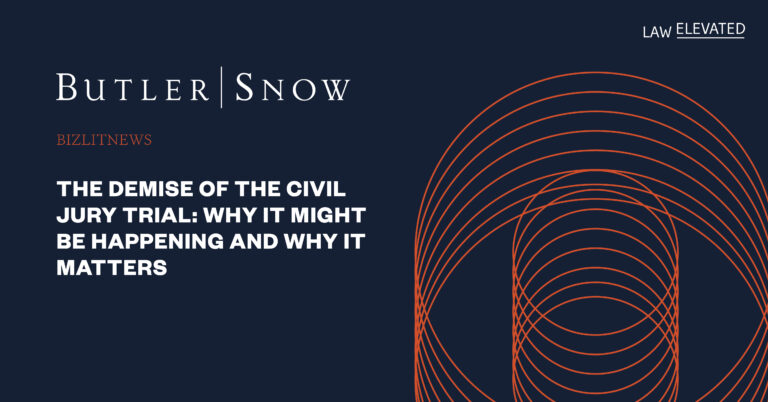Much has been written about the demise of the civil jury trial, while not as much has been written as to whether this is a good or bad development. California Superior Court Judge Curtis Karnow, writing recently in the American Journal of Trial Advocacy, made a self-described heretical suggestion that perhaps civil jury trials are counterproductive and “contribute to unaffordability of the civil justice system.” (“Heresy: A Practical Argument Against Civil Jury Trials”, Vol. 48, No. 2, Spring 2025 at 322). While this writer respectfully disagrees with Judge Karnow, that debate is best left to another blog.
Whether for good or bad, the numbers don’t lie – civil jury trials are on a downward trend and have been for many years. Even aside from the precipitous drop during COVID, statistics show that only a minute number of civil filings result in jury trials. For example, according to the Administrative Office of Courts data found on the USCOURTS.GOV website, there were 1,406 civil trials in all federal courts across the country in fiscal year 2023. That represents .7% of civil cases. And this is after a 22% increase in filings that same fiscal year. For comparison, in fiscal year 1990, there were 4,783 civil jury trials (with 80,000 fewer cases filed), or 4.3% of civil cases. In Alabama, where this writer practices, there were only 19 civil jury trials across all three federal districts from April 1, 2023 to March 31, 2024.
State courts saw similar declines. According to the National Center for State Courts (NCSC), jury trials accounted for only .04% to .15% of filings in 2023. And this miniscule state court civil jury trial rate has been that way for at least the past 12 years. Even before COVID, NCSC data show the rate of jury trials per 100,000 population in 2007 was 58.6, but by 2019 that rate had fallen to 37.7 per 100,000, a 26% decrease.
So why the steep and prolonged decline? Well, Judge Karnow is certainly on to something when he writes about the expense of jury trials. Long gone are the days walking into trial a few months after suit was filed with only your client, having conducted no discovery or depositions. Now, pretrial discovery has become the tail that wags the dog. Often stretching over years and involving enormous quantities of documents, data and the now ubiquitous electronically stored information (ESI), and the time-consuming process of organizing and reviewing all that information, the pretrial discovery process has significantly increased the cost of preparing a case for trial and actually trying a case. Just to get to trial requires an investment by parties of time and expense approaching (if not exceeding) 6-figures in some cases. The cost-benefit analysis for this wide-open pretrial discovery process can certainly lead parties to try and avoid this if possible.
Another possible explanation is the increase in alternative dispute resolution practices such as mediation and arbitration. Trial courts (state and federal) now routinely order parties to mediation as part of scheduling and case management requirements. This forces parties to the table to at least attempt a negotiated resolution at some point prior to trial. And indeed, a very high number of cases do, in fact, settle prior to trial.
As mentioned above, civil filings are up in federal courts, yet jury trials are down. That points to another possible reason for the decline – greater use of motion practice to dispose of cases that either have no legal merit through motions to dismiss or fail to survive summary judgment after evidence is developed.
Whatever the reason(s) for the steep reduction in civil jury trials, one ramification of the decrease is extremely concerning (and here, I think Judge Karnow might agree with me) – the inability of young lawyers to get jury trial experience. We have a generation of lawyers in trial or litigation practices who practice for years to start their careers without ever having had the opportunity to conduct (or even attend) a civil jury trial. In my opinion, the legal profession is facing a crisis from the decline in jury trials, because in 20+ years, these young lawyers will be the “senior” litigators and trial lawyers but may have only a few jury trials under their belts. Without being able to develop and utilize trial advocacy skills, my fear is these skills will become a lost art. I believe this is lamentable as this will adversely impact the ability of lawyers to provide this service to the public and clients and to counsel clients on the risks or benefits of trial. It is for this reason I hope the legal profession will find ways to reverse the decline of civil jury trials.
